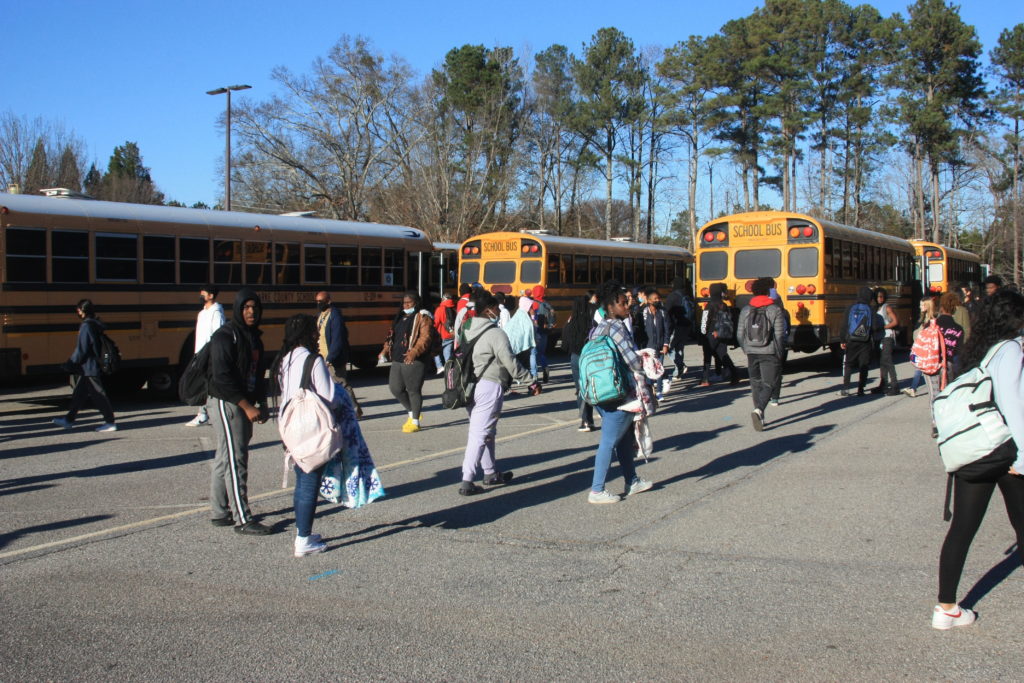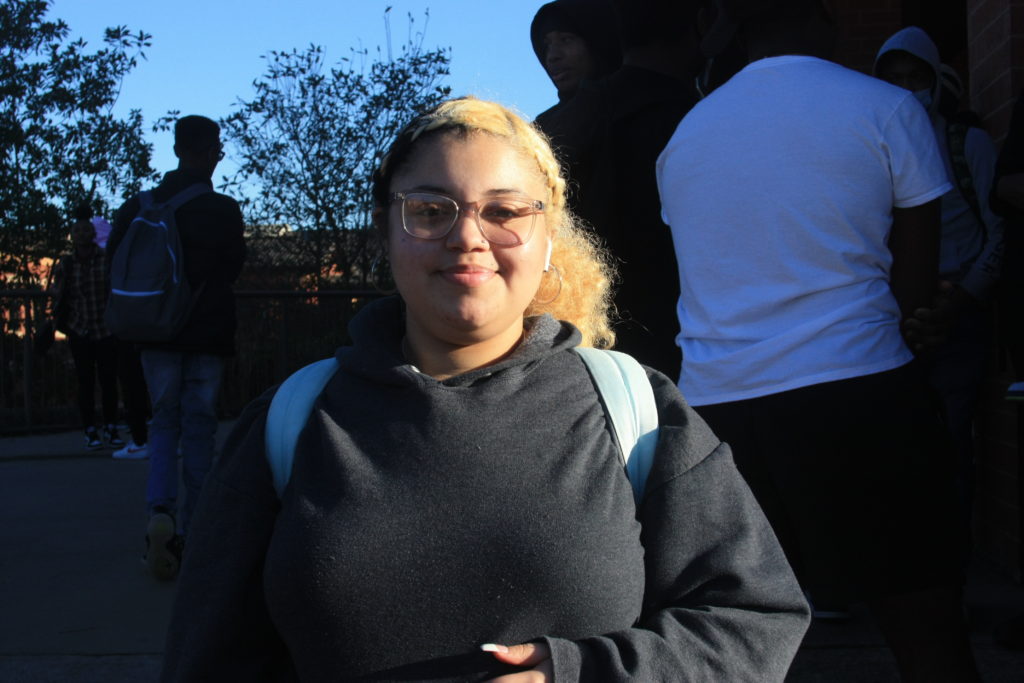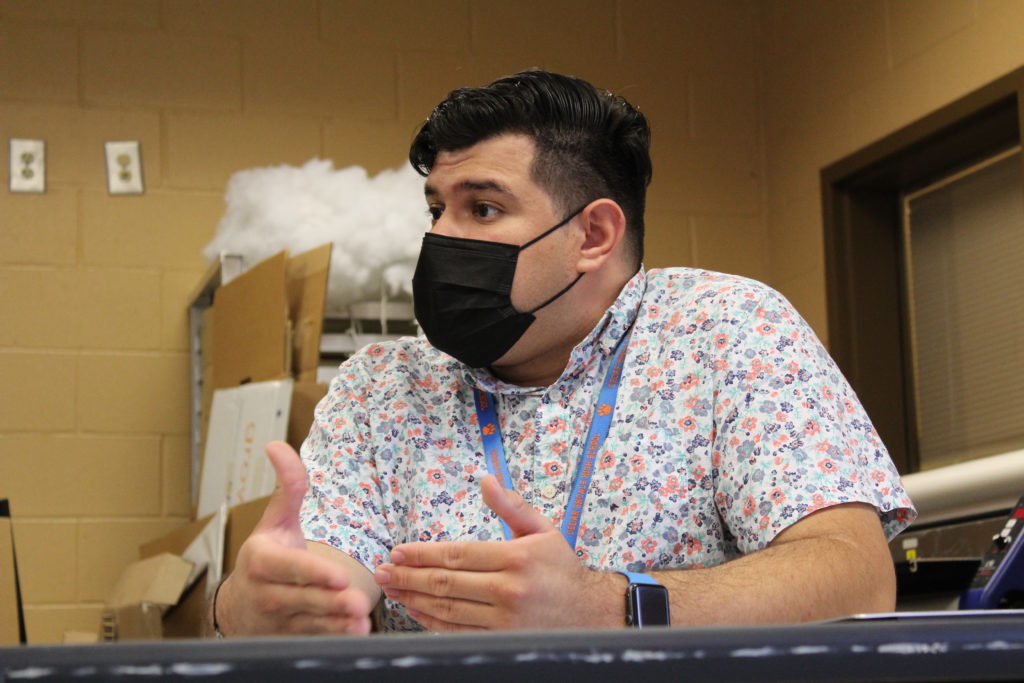CCSD bus drivers cooperate and sacrifice to transport students
By 9:00 a.m. every morning Clarke County bus driver Sondra Riden has delivered three buses of students to school. Elementary, high school and Athens Community Career Academy students know Ms. Riden, and after 20 years driving she remembers many of them.
“You have to love what you do to continue to be a bus driver. You have to love your job and love your children,” Riden said. “Each day is a new challenge.”
This year a shortage of hired bus drivers has combined with effects of the pandemic to stretch Clarke County School District’s transportation department. According to Chief of District Services Dexter Fisher, the department currently falls short of the necessary 160 bus drivers.
“On average we should have 160 drivers,” Fisher said. “Around the country and around the state there is a shortage of drivers.”
As of Jan. 18, 112 bus drivers were working for CCSD. In 2020 through September 2021 there were 119 drivers, and 139 in 2019. According to Director of Transportation Mark Weaver, drivers cover about 112 routes for approximately 8,500 bus riders across CCSD and 400 at Cedar Shoals.
Joseph Hillsman, a driver for Cedar Shoals High School and Barnett Shoals Elementary, says the shortage of drivers is nothing new.
“There’s been a shortage ever since I’ve been here, and I’ve been here almost 27 years,” he said. “Driving a bus is a very difficult thing: you’ve got to get a CDL (commercial drivers license), you’ve got to pass drug tests, you’ve got to pass background checks and you’ve got to know how to handle kids. A lot of people can’t do that.”
The job also requires drivers to be at least 21 years old with a high school diploma or GED.
“Even when I started teaching in 2018, we always had a double route at school. We haven’t had enough drivers for years, and it just got worse,” Brian Heredia, Cedar Shoals teacher and bus driver, said. “It’s that constant struggle of making sure that we have every student covered, and every student gets home.”
Drivers are paid by the hour, starting at $16.26 and capping at $23.69 for drivers with 20 years of experience. They are not paid overtime until they exceed 40 hours of work in a week, which is unusual with drivers’ normal hours, according to Heredia.
“It (an additional route) might be an extra $13 to $18 (depending on the driver’s hourly rate). To deal with the stress of having up to a full bus of students yelling at you because you’re their sub driver, trying to get them home, and you’re already late to pick them up, it makes you a little more reluctant to volunteer to do that,” Heredia said.

As a contracted teacher, Heredia’s work before 8 a.m. and after 4 p.m. counts for overtime pay. He arrives at Cedar at 7:30 a.m., where his bus stays so he can get to class on time after his morning route. Usually he has completed the morning route by 8:10.
Heredia learns which route he will drive each afternoon around lunch time. He leaves his class at 3:30, five minutes before the bell rings, to prepare for the first route. Heredia says he may be done with afternoon routes any time between 4:45 and 6:30.
“When I’m done I always call in and check if they need any more help. When I’m in that situation where I can help out, and the only way I make money driving the bus is overtime, I’ll take the hours that I can get as long as I’m done before seven,” Heredia said.
Hillsman says drivers are asked to do more work this year, but he tries to maintain his normal schedule.
“I don’t like to do a whole lot of overtime, because I’m old,” he said. “Driving will hurt your shoulders, and everything else. So I just try to do my route, come in, and make sure they don’t have to worry about me.”
According to Fisher, if a driver is out, the rest of their team will coordinate to ensure the absent driver’s students make it home.
“They’ll get together and say okay, how can we split up those kids. That’s a testament to their sacrifice and their wanting to get our kids home,” he said. “We’re in the business of educating our children. The incentive to our drivers is that we’re not going to leave any child behind.”
In September CCSD Superintendent Dr. Xernona Thomas announced potential plans to implement hazard pay for drivers in a Facebook post.
“We recognize that while everyone in the community and schools has some exposure to COVID, bus drivers work in a uniquely challenging environment,” Dr. Thomas wrote. “They are in close proximity to students with no way to move further away and some bus routes have more students than allow for consistent social distancing. Bus drivers do not have a mechanism to enforce mask wearing or remove a student to an administrator’s office; they need to be focused on driving.”
Dr. Thomas also cited the $2,000 retention bonus that all CCSD staff are receiving in phases. By the end of the school year, drivers will have received four $500 payments.
“I’m very happy with the retention bonus,” Riden said. The hazard pay proposal however, was not executed.
“It is a hazard to drive a bus. Whether Clarke County will pay you hazard pay, I doubt it. What can you say?” Hillsman said.
Fisher says the proposal is still being considered.
“How do you look at the hazard pay of all our employees, teachers, everybody? It’s something that we looked at, we’ll continue to look at that, but we have not done hazard pay as of right now,” Fisher said.
Masks are required inside CCSD schools and buses. Fisher says the district supplies drivers with masks to hand out to students without them. But students do not always comply.
“The people on my bus don’t really like to follow rules. You should do it to help you be safe,” junior Alondra Sanchez said. “If you don’t wear a mask on the bus, you risk everyone on the bus getting COVID-19, and probably the bus drivers too.”
As of Jan. 19, there were 957 January COVID-19 cases in CCSD. There were 33 in November and 49 in December compared to 307 in September and 503 in August. In the week of Jan. 12, the case rate in Athens was 1,488, and there were 166 new hospital admissions.
“On my bus there’s people who wear masks. But a majority don’t wear their masks,” junior Kaylynn Hitchcock said.
Heredia worries that the lack of student mask compliance could put his fellow drivers at risk.
“It’s a bit easier for me to not make a big fuss about it, because especially my first couple of big groups, they’re off my bus within 15 minutes,” Heredia said. “But for a driver who has to drive 20 minutes to get to their first stop, I know that’s a much bigger issue for them. Drivers can get cases from the bus, drivers probably have gotten cases from the bus and drivers have been out sick for it.”

Hitchcock also reports that her bus is frequently overcrowded to the point that students sit three to a seat or stand in the aisle.
“You can sit three to a seat, but if you’re in the aisle, that’s not good. If we had a crash or something the seat is supposed to stop the shock,” Hitchcock said.
Crowding is worst when everyone who usually has after school activities rides the bus on Friday afternoons, she says.
Fisher acknowledges that overcrowding has been an issue on buses this year.
“I’m not going to shy away from the fact that our buses have been extremely overcrowded. It’s unfortunate, the biggest thing is because of the shortage of drivers,” Fisher said. “Our number one goal is to transport all our students safely. Granted some of our students are standing up, which is not safe to do. Our bus drivers work really well together to try to alleviate some of that overcrowding so we can transport our children safely. I wish I had a crystal ball to see how we can answer this.”
Normal timing issues like traffic or behavior issues that require a driver to pull over combine with the need for drivers to coordinate to cover routes. Hitchcock says this affects the times she gets to school and home. She regularly gets to school at 8:30 or 8:40, and first period begins at 8:45. This means she can not access morning tutoring opportunities.
“My third period teacher makes a big deal about me not coming to his class for help in the morning. I take Algebra 2 honors,” Hitchcock said. “He gets to school at 7:45, and he does help from 8:00 to 8:45. I tell him I ride the bus and there’s nothing I can do about that.”
In the afternoons, Hitchcock may not get home until between 5:00 and 5:30, which makes it difficult to get to her job on time. She starts work at Old Navy at 5:30, then closes, and gets home for the night between 10:00 and 10:30.
“The one class I do get homework for, I never get to do it. After school and work, I’m tired. I’m ready to go home and go to sleep,” she said.
Junior Wilson Teyul says his bus is on time in the mornings, but his afternoon route takes longer.
“I’ve got to do after school stuff, because I’ve got my own personal life going on and projects as well,” Teyul said. “I’m working right now. Sometimes it makes it hard to get to work.”
Sophomore Amari Davis was waiting for his bus one afternoon when his friends decided to walk instead. Even though they live in a neighborhood by Barnett Shoals Elementary School, 2.8 miles away from Cedar, he said they walked to save time.
“It doesn’t really take them that long. The bus takes longer,” Davis said. In the mornings, Davis’ parents sometimes give him a ride when the bus is running late.
“My dad has a night shift, so it doesn’t really bother him. It just bothers his sleep. It mainly bothers my mom, because she has to worry about me getting to school early. She goes to work at like 8 a.m.,” Davis said.

Fisher says he is working to address the issues of overcrowding and timing with rerouting and recruitment efforts.
“One thing that we’re going to look at in the future is making sure that we’re being efficient and making sure that we’re routing our drivers the right way, so we can optimize our drivers to make sure that we’re doing all we can to get our students to school on time and get them home,” he said. “So probably next school year, our routes are going to look a little bit different.”
While the retention bonus serves to incentivize drivers to keep working for CCSD, there is also a payment incentive for recruiting new drivers.
“We’ll be very aggressive from now until the end of the school year. Then we have the summer to train those folks and get them ready for the school year,” Fisher said.




